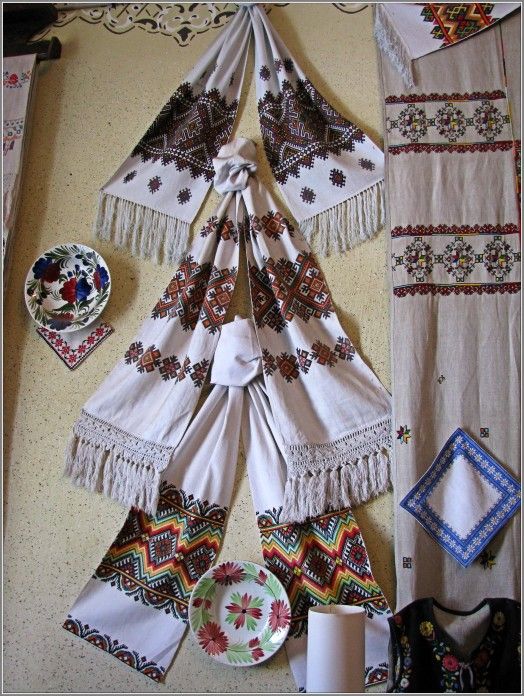 In Ukrainian folk culture, the towel is considered one of the most noticeable and revered products. Towels are used in all rituals that accompany Ukrainians throughout their lives - from birth and christening to burial. The embroideries that decorate ceremonial festive towels represent the art of folk craftsmen who create amazing colorful patterns on the canvas that arouse admiration in any person who knows how to appreciate beauty. The greatest value of towels is that behind the beauty visible to everyone, there is hidden the symbolism of special ornaments known to connoisseurs, in which knowledge about life, people, and the connection of a person with his ancient family is encrypted.
In Ukrainian folk culture, the towel is considered one of the most noticeable and revered products. Towels are used in all rituals that accompany Ukrainians throughout their lives - from birth and christening to burial. The embroideries that decorate ceremonial festive towels represent the art of folk craftsmen who create amazing colorful patterns on the canvas that arouse admiration in any person who knows how to appreciate beauty. The greatest value of towels is that behind the beauty visible to everyone, there is hidden the symbolism of special ornaments known to connoisseurs, in which knowledge about life, people, and the connection of a person with his ancient family is encrypted.
Towels were very widely used in Ukrainian life. A small part of them, of course, served as ordinary household towels, which were decorated quite modestly. The main purpose of towels is to protect people from all evil and attract good and health to the owners of the towel. For this, Ukrainians decorated their houses with them, tied towels to icons, used them as clothing, and used them in rituals. In the Middle Dnieper region, there has long been a custom to wear a beautifully embroidered towel as a ceremonial festive belt. Such a towel was necessarily embroidered with symbolic ornaments intended for this person and corresponding to the ritual performed.
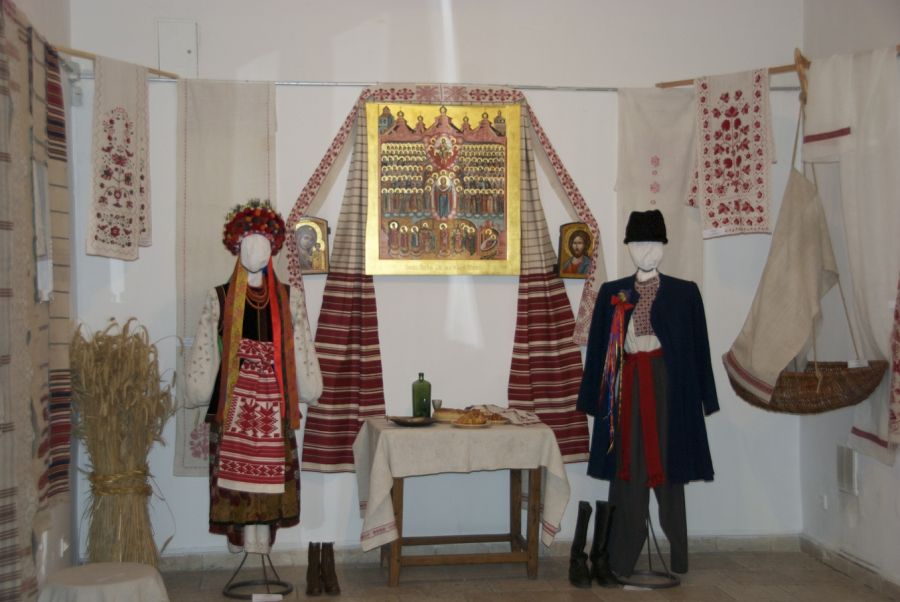 The belt in the Ukrainian costume was intended not only for practical purposes. It was an obligatory element of clothing, without which it was considered unseemly to appear outside the house, in public. The expression "to untie" meant to lose one's sense of self-esteem, to disrespect others. The belt could serve as a talisman for its owner, especially if a towel richly embroidered with ornaments with magical symbols was used as a belt. The towel-belt was worn to perform rituals, it brought happiness and protection to a person. As an attribute for performing rituals, the Ukrainian embroidered towel was constantly used in folk and family events, such as family, engagement, wedding, funeral.
The belt in the Ukrainian costume was intended not only for practical purposes. It was an obligatory element of clothing, without which it was considered unseemly to appear outside the house, in public. The expression "to untie" meant to lose one's sense of self-esteem, to disrespect others. The belt could serve as a talisman for its owner, especially if a towel richly embroidered with ornaments with magical symbols was used as a belt. The towel-belt was worn to perform rituals, it brought happiness and protection to a person. As an attribute for performing rituals, the Ukrainian embroidered towel was constantly used in folk and family events, such as family, engagement, wedding, funeral.
In Ukrainian customs, a family ritual is very important when a baby is just born. This is a tribute to the mother and her newborn child. From the first minutes of a child's life, the care of the family accompanies the child, whose members, through rituals, created protection from adverse forces, protected the baby and his mother with the help of amulets, the main place among which was occupied by embroidered towels. In addition to towels, other attributes were used in families: a fur coat, a fur hat, purified water. The symbolism of the ornaments of towels, specially embroidered for this ritual, created a protective barrier against diseases, curses and predicted a happy fate for the baby.
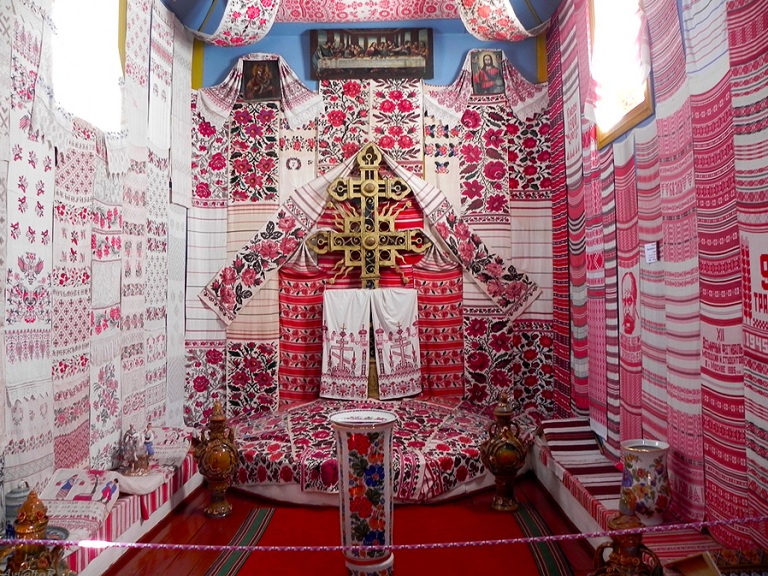 Ukrainian folk weddings also widely use various towels. At all stages of the wedding celebration - matchmaking, festive engagement, Karavayni rite, parental blessing, gift-giving - beautiful towels were used, specially embroidered with special patterns for each specific ritual.
Ukrainian folk weddings also widely use various towels. At all stages of the wedding celebration - matchmaking, festive engagement, Karavayni rite, parental blessing, gift-giving - beautiful towels were used, specially embroidered with special patterns for each specific ritual.
Many names of wedding rituals emphasize the importance of towels during the ceremony. Often, the matchmaking itself was called that - towels (common in the Kharkiv region). In the Kyiv region, matchmaking was called giving towels, and in the Kirovograd region, taking or giving towels. When a girl agreed to marry, she tied towels embroidered by her own hands to the matchmakers, and bread was also offered to the desired matchmakers on an embroidered towel. The matchmakers accepted these gifts and expressed gratitude to the girl's parents for raising her well, and the girl was praised and thanked for her hard work and skill, which was evident in the beautiful towels embroidered by her. In some Ukrainian regions, an engagement ceremony was used, which was held before the wedding. It was also called "towels". This ritual, during which the hands of the future newlyweds were tied with a towel, was conducted by the village headman. The loaf was covered with an embroidered towel, on which the bride and groom, as well as their relatives, placed their hands. The elder solemnly tied their hands with this towel. Then the elder delivered a short ceremonial speech and untied the towel. After that, the bride tied the towels she had embroidered on her matchmakers, and presented the participants in the engagement with scarves, linen, and embroidered clothes.
On sad days of funerals, clean white towels and handkerchiefs were hung on the windows of houses.
Symbols used in Ukrainian ornaments
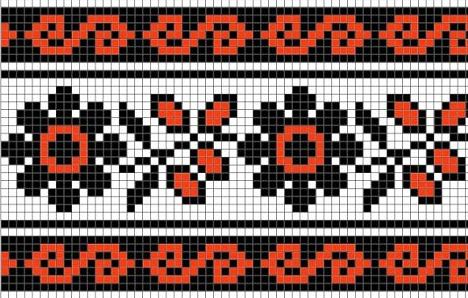 Symbols meaning Sun and Water.
Symbols meaning Sun and Water.
Ukrainian towel embroidery is characterized by the frequent use of patterns that are signs of the Sun and Water - two fundamental elements that created and support life on Earth. They are identified with the solar energy of the Father and the water energy of the Mother. An octagonal rosette or flower denotes the Sun, and a pattern resembling a coiled snake symbolizes Water.
The obligatory symbol of embroidery of every towel, especially a wedding towel, is considered the Mother's symbol. It is an octagonal pattern in the form of a flower or a star, around which a symbolic garland of flowers is embroidered. The garland signifies the glorification of the Mother and her invaluable participation in the continuation and protection of every family.
Diamonds are the most common geometric type of pattern in the embroidery of all Slavic peoples. Also in Ukrainian embroidery of towels, diamonds occupy the most important place among all geometric symbols. Patterns with diamonds were considered a strong amulet, bringing happiness. According to ancient Slavic beliefs, diamonds denote the goddess of the Earth, which promotes fertility. Due to this meaning of this symbol, diamonds were widespread and actively used in ornaments of the national clothing of the Ukrainian people. Now you can see beautiful embroidered shirts and other items of clothing on Ukrainians, embroidered with rich ornaments using the symbolism of the diamond. But patterns with diamonds on ceremonial towels are especially popular.
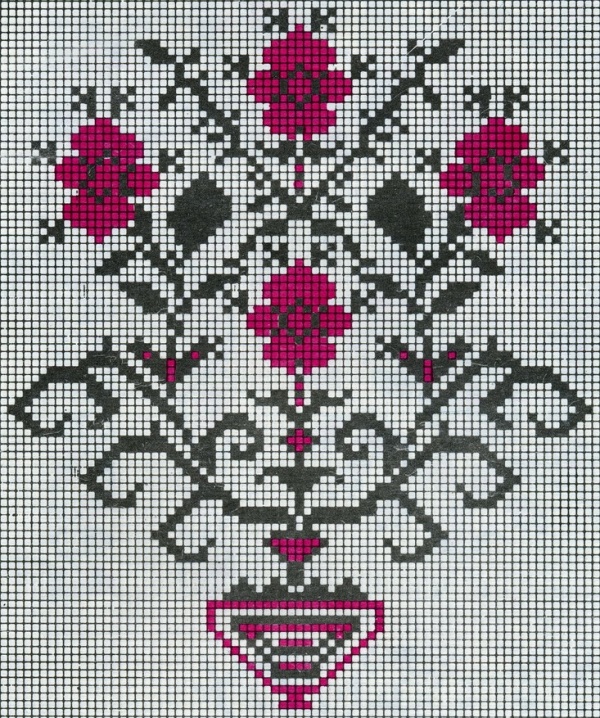 Ornament in the form of a flowerpot or Beregin
Ornament in the form of a flowerpot or Beregin
A significant amulet in classical Ukrainian embroidery in terms of strength and influence is an ornament representing a flowerpot with a flowering tree and birds, or Berehynia - a large mystical flower or a stylized figure of a woman. Such an ornament symbolized an amulet, cleansing from evil, healing and protective magic. Red threads were used for its embroidery, sometimes black ones were added. Traditionally, the red color in Ukrainian embroidery is a symbol of the sun, as well as fire, which cleanses from bad influences on a person.
Ornaments depicting grapes are embroidered throughout Ukraine. In the Kyiv, Chernihiv, and Poltava regions, ornaments on embroidered cloths and towels with large bunches of grapes are especially popular. The bunch of grapes on the ornament is a symbol of creating a family, its beauty and well-being, and also resembles a strong and numerous family.
A geometric ornament representing a large number of stars, embroidered on the edges of towels or sleeves of embroidered shirts, tells of the stable order and beautiful harmony created in the lives of people and in the entire Universe.
In pagan mythology, the god Perun was considered the strongest and most formidable god. The symbolic tree of Perun was the oak. Therefore, the oak is considered a symbol of invincibility, strong vitality, and male energy. Towels and clothes of Ukrainian men were decorated with patterns consisting of images of the oak. This gave them courage and strength to protect the Ukrainian family.
Kalina has always been revered as a talisman of the Ukrainian family. It is believed that the name of the viburnum comes from the Old Slavic word "kolo", which our ancestors called the Sun. This small tree with beautiful clusters of flowers and fruits was planted by Ukrainians in every yard. The red berries of the viburnum represent a healthy and immortal lineage, so Ukrainian craftsmen loved to embroider clusters of bright red viburnum berries on embroidered shirts and wedding towels.
The fragile, delicate lily flower symbolizes virginity, beauty, and charm. Often, the lily ornament is designed so that a pair of swans can be seen in it, which means eternal fidelity and sincere love. The lily is embroidered in a triple pattern - flower, leaves, bud. The lily represents feminine energy, the symbol of which is Water. The ancient name for the lily is "kryn". This word is consonant with the Ukrainian word "krynytsia", which means well. In the lily ornament, water is often represented by the image of several dew drops above the flower, which denote fertilization.
According to Ukrainian folk beliefs, poppy has magical powers, protects the family and household from various troubles. Family members, the house, the yard and animals were sprinkled with consecrated poppy seeds. The bright red color of the poppy symbolized the blood of soldiers who died on the battlefield. The ornament on the towel, which depicts a poppy flower, seed pods and leaves, symbolizes protection from evil and the faithful memory of the soldiers from this family who died in battles. Young girls from the family of the deceased warrior embroidered patterns with poppies on their shirts and wore wreaths woven from seven poppies. This meant their obligation to the family to preserve and continue their lineage in memory of the deceased.
The rose has always been popular and beloved in Ukraine, it was considered the flower of the Sun, and the red color of roses, reminiscent of the color of blood, was considered a symbol of life. Ornaments consisting of flowers, rose leaves, are collected in a wide strip in the form of an endless wreath that has neither beginning nor end, which means the infinity of life with its constant rebirth. When the ornament of roses was embroidered symbolically, with geometric patterns, then roses could denote stars that are collected in the infinite space of the sky in a certain system.
Ornaments that include hop leaves can often be found on towels and embroidery of residents of central Ukraine and Podillia. This symbolism is usually attributed to youth. Hops denote youthful love, youthful enthusiasm, activity and development. Outwardly, the drawing depicting hop leaves resembles ornaments of grapes and water, since the symbolic meaning of the hop sign contains part of the meaning of these two signs. The hop symbol is sometimes considered wedding, since it personifies a young family and the course of life.

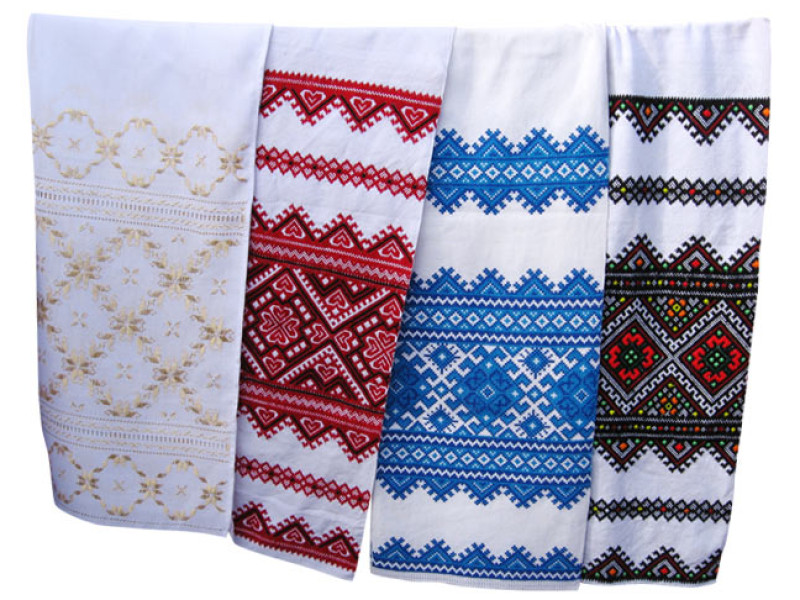

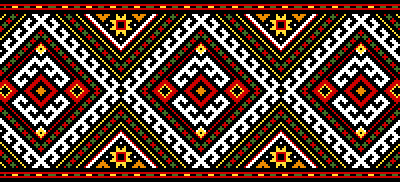

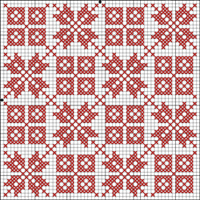
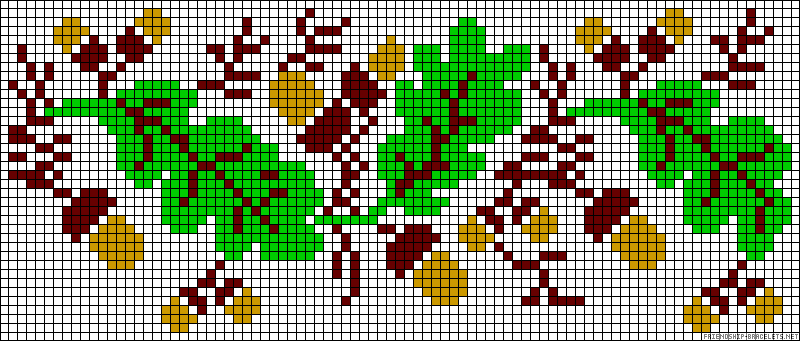
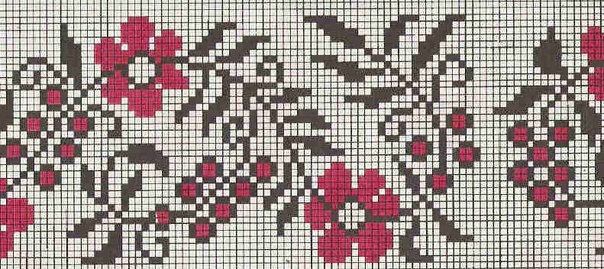
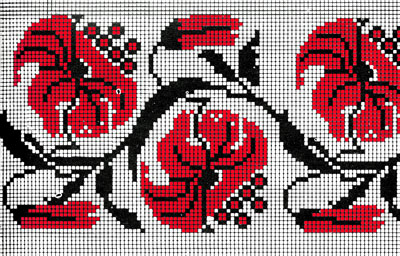
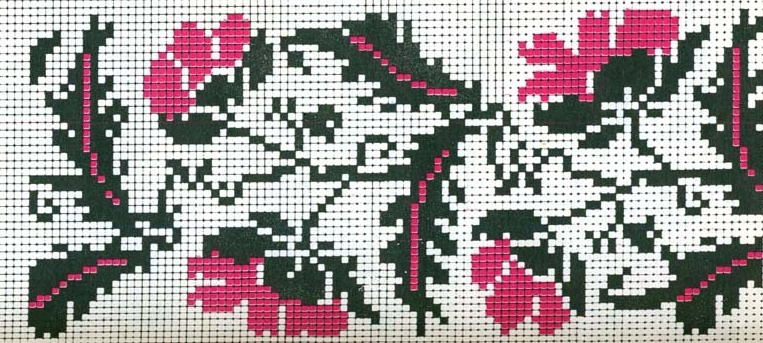
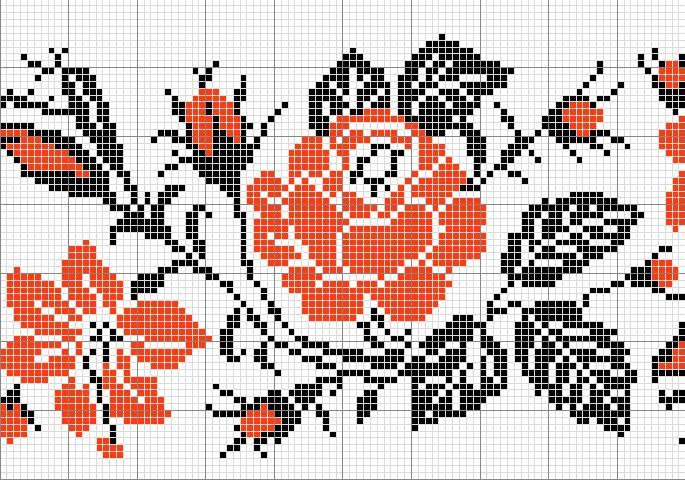
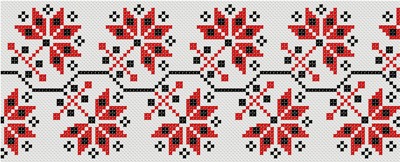
Write a comment